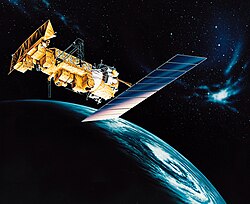ITOS-B
Appearance
NOAA[1] | |
| COSPAR ID | 1971-091A |
|---|---|
| Mission duration | Launch failure |
| Spacecraft properties | |
| Manufacturer | RCA Astro |
| Launch mass | 687 kilograms (1,515 lb) |
| Start of mission | |
| Launch date | October 21, 1971, 00:00 UTC SLC-2E |
| Orbital parameters | |
| Reference system | Geocentric |
| Regime | Sun-synchronous |
| Epoch | Planned |
ITOS-B was a
TIROS.[3]
ITOS-B was launched on October 21, 1971 from
second stage
launch vehicle caused the spacecraft to reenter the Earth's atmosphere about 1 hour after lift-off.
Description
ITOS-B was designed to provide improved operational
IR radiation
but could also serve as a backup system for the APT and AVCS cameras.
The nearly cubical spacecraft measured 1 by 1 by 1.2 meters (3.3 ft × 3.3 ft × 3.9 ft). The TV cameras and infrared sensors were mounted on the satellite baseplate with their optical axes directed vertically earthward. The satellite was equipped with three curved solar panels that were folded during launch and were to be deployed after orbit was achieved. Each panel measured over 4.2 meters (14 ft) in length when unfolded and was covered with 3420
gyroscopic principles incorporated into the satellite design. Earth orientation was to be maintained by taking advantage of the precession induced from a momentum flywheel so that the satellite body precession rate of one revolution per orbit would provide the desired 'Earth looking' attitude. Minor adjustments in attitude and orientation could be made by means of magnetic coils and by varying the speed of the momentum flywheel.[1]
References
- ^ a b "NASA/NSSDC ITOS-B spacecraft details". Retrieved June 7, 2018.
 This article incorporates text from this source, which is in the public domain.
This article incorporates text from this source, which is in the public domain.
- ^ McDowell, Jonathan. "Launch Log". Jonathan's Space Page. Retrieved June 6, 2018.
- ^ Wade, Mark. "ITOS". Encyclopedia Astronautica. Archived from the original on June 21, 2002. Retrieved June 7, 2018.
- ^ "NOAA 1 / ITOS A, B, C / TIROS-M". Gunter's Space Page. Retrieved September 9, 2024.

